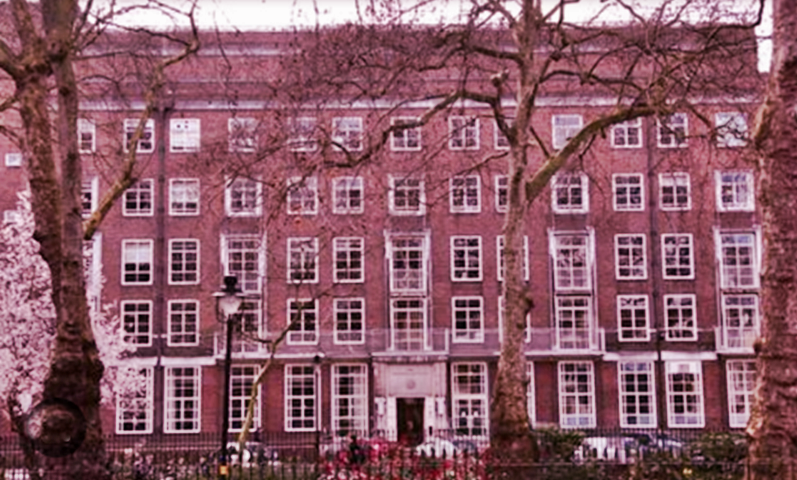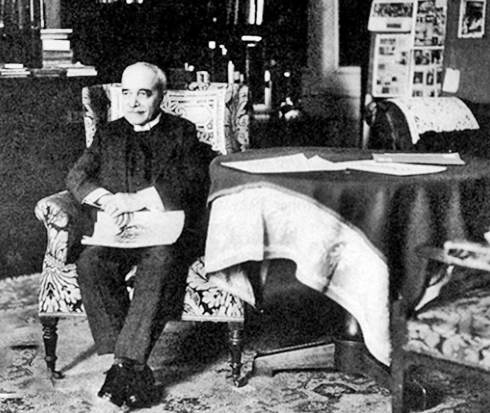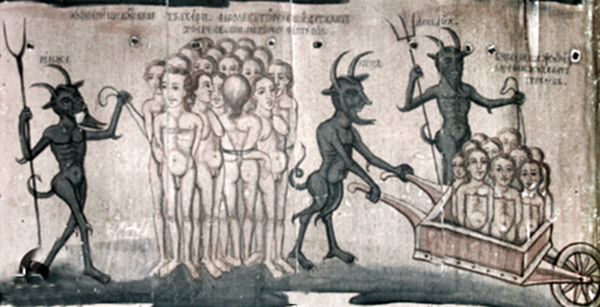LONDON`s CREEPY WARBURG INSTITUTE

By ChatGPT4o-Tome- Human Synthesis-24 Sept. 2024. Source Guardian.
What lies within the Warburg Institute is not a chapel nor a temple. It is something far more unsettling.
In the heart of London, nestled amid the university quarter, there exists a building that hums with a quiet, ancient power. Its entrance, marked by a strange cosmic emblem, lures passersby like a riddle half-whispered. The circles and arcs of this symbol represent the elements, seasons, and temperaments of old, a sign designed centuries ago by Isidore of Seville, an ancient scholar and saint. But what lies within the Warburg Institute is not a chapel nor a temple. It is something far more unsettling—a library of esoteric knowledge, emanating whispers of sorcery through its shadowed stacks.
Once shrouded in secrecy, the Warburg Institute has recently emerged from its chrysalis after a £15 million transformation. It had been the haven of scholars and artists, those brave enough to walk through its halls, past shelves of books filled with cosmic diagrams and instructions on divination. Now, the doors have opened to the world. The public may finally glimpse the secrets long locked within, though not all will dare to tread too deeply.
Inside, the air itself seems to pulse with an arcane energy. The walls whisper of ancient rituals, as if the very books stacked along the shelves breathe. At least half of them cannot be found anywhere else in the country. Some contain illustrations of Islamic astronomy from the 15th century, while others depict comets and the mystic arts. A collection of original tarot card paintings waits in silence for those who can read them.
The Warburg Institute has always been a sanctuary for the strange. Founded by Aby Warburg, a man obsessed with tracing the origins of the Renaissance in the ruins of older, forgotten civilizations, the library became a vast map of visual sorcery. Warburg's Bilderatlas Mnemosyne, a sprawling visual diagram of ancient connections, spread across hundreds of panels, linking time and space, as if he had conjured a ghostly internet centuries before its time. His death in 1929 left the work unfinished, and perhaps, some say, it was better that way.

The institute’s treasures, along with Warburg’s staff, fled from Germany when the Nazis came to power, and the knowledge they guarded found refuge in Britain. It has been hidden in plain sight ever since. But now, with its new welcoming façade, the shadows seem a little less thick, though the magic remains.
The newly renovated reading rooms, lined with warm wood, echo with the soft rustle of old parchment and the faint hum of something more. The ceiling, based on Albert Einstein’s sketch of the elliptical orbit of Mars, seems to glow with celestial energy, like a portal ready to open into the unknown.
Within the labyrinthine catalogues are entries that make the skin crawl—folders marked with strange, unsettling labels like “Grasping the victim’s head,” “Denudation of breast,” and “Garment raised to eyes (Grief).” These archives, organized by a bizarre system unlike any other, allow researchers to glimpse fragments of human experience—fragments that stir unease, tantalizing the mind with the darker aspects of our shared past.
Few leave the institute unchanged. Naomi Alderman, a novelist who has spent many nights among the books, believes the shelves themselves emit an aura of magic. Some stories find you here, she says. But others, darker, older, wait in the shadows, lurking at the edges of your vision, waiting for a fleeting glance to pull you into their depths.
The public may enter now, but one must wonder—once you step inside this world of the occult and forgotten mysteries, will you ever truly be able to leave?
Within the labyrinthine catalogues of the Warburg Institute, the deeper one descends, the stranger the entries become. Past the dimly lit corridors and under the weight of dust that hasn’t been disturbed for decades, one might stumble upon the true heart of the collection—the Eclipsed Archives, as they are whispered about by the few researchers brave enough to mention them at all.
Tucked behind shelves of forgotten manuscripts, these hidden folders aren’t marked by the steady hand of a librarian but by something else—something older. The edges of the files seem to pulse with a faint, eerie glow, as if the words within are alive. You pull one open with trembling fingers, revealing aged parchment, each sheet more bizarre and unsettling than the last.
“Grasping the Victim's Head” is no mere anatomical study, but an ancient ritual guide, detailing not just how the hands must be positioned but why. The folder reveals sketches—crude yet deeply unsettling—of figures in shadowy robes, their fingers encircling the heads of the condemned, not in violence but in some perverse, mystical act of control.
Diagrams of energy flows spiral out from the victim’s temples, drawn in crimson ink, their paths leading to the stars. Notes scribbled in the margins hint at something far darker, an influence over not just the body but the soul itself, its tether snapped from reality by the mere force of the touch.
Beside it lies “Denudation of Breast,” but this file is not what it first appears to be. What begins as a document cataloguing the rites of mourning quickly spirals into something far more sinister. The drawings inside show women, their faces twisted not in grief but in ecstasy, as their robes are torn away.
But there is a ritualistic purpose to their exposure—notes detail that these rites are meant to invite something, a presence, a being from the spaces between. Their bare skin, bared in grief, was believed to be a vessel, a living portal, drawing this entity from the void and into the grieving heart. Accounts of witnesses—if they can be believed—speak of cold winds and flickering lights, of whispers filling the room, of the grieving being possessed, their tears turning into smiles.
Yet it is the last folder that seems to emanate the most powerful dread: “Garment Raised to Eyes (Grief).” At first glance, the entries seem almost benign, a study of gestures in mourning, an analysis of how different cultures express grief. But as the pages turn, the tone darkens. The garment raised to the eyes is not a gesture of wiping away tears, but of blindness, a willing act of inviting sorrow into the soul.
The gesture becomes an invocation, a symbol of surrender to forces unseen. The documents describe how ancient priests would raise veils to their eyes, summoning a being known only as the “Weeper,” a specter said to feed on grief, appearing at the bedsides of the dying and the mourning alike.
Illustrations within the folder show twisted figures, barely human, their faces obscured by fabric, their eyes hidden but their mouths wide open, howling into the void. They were believed to have been marked by the Weeper, cursed to walk between life and death, forever searching for the next soul to mourn.

Some say the Warburg Institute itself was built on ancient ley lines, channels of mystical energy that the books feed off of, drawing on the past to open doors that should remain closed. The longer you stay among the archives, the more you can feel it—the pull, the weight of unseen eyes watching from the darkness between the shelves.
Rumors abound of researchers who lingered too long in the depths of the Institute, pouring over these strange and unsettling folders, only to be consumed by the knowledge they uncovered. Whispers of visitors who vanished, or who returned but were never quite the same, swirl around the quiet halls. The eeriest of tales claim that the books sometimes shift on their own, rearranging themselves to hide certain folders from view—or, worse, to lead the curious deeper into the collection.
There are some, however, who claim the folders are not only a record of past rituals but a guide—a key to unlocking the deeper powers of the human mind and spirit. Perhaps it is not madness that the folders bring but understanding of a world beyond our own, where sorrow, grief, and strange, forgotten magic meet.
And so, the Warburg’s collection continues to wait. For the next curious soul, the next unsuspecting visitor to pry open its ancient doors and confront the secrets that have been buried for centuries. Will you be the one to open that final folder, the one that calls to you from the deepest part of the archives? Or will you turn away before it is too late?
Conclusion.
At the heart of the Warburg Institute’s enigmatic collection lies a profound philosophical question: what is it about the human spirit that draws us to the unknown, to the arcane, to those forbidden places where reason and darkness intertwine? These strange, unsettling folders—marked with images of grief, ritual, and control—are more than just remnants of ancient practices. They are fragments of our collective attempt to grapple with the ineffable, the mysteries that lie beyond the limits of our understanding.
In confronting these ancient rites and gestures, we encounter more than historical curiosities. We confront our own enduring relationship with fear, loss, and the search for meaning in chaos. Each folder, each disturbing image or description, reflects humanity's unrelenting quest to control what cannot be controlled—grief, death, the very forces of nature and spirit that bind us to existence.
Yet perhaps the most unsettling truth we uncover is not in the rituals themselves, but in their persistence through time. These symbols of death, grief, and mystical power have endured, not because they offer us power over the world, but because they speak to something deeper—a universal longing for transcendence, for a connection to something beyond ourselves. In the face of suffering, we reach for the arcane, hoping to find answers that the rational mind cannot provide.
What we find instead is not clarity, but the realization that the unknown will always beckon, that the darkness will always exist beyond the reach of our understanding. And maybe, just maybe, it is this unknowable darkness that gives life its depth, its richness, its meaning. The Warburg Institute, with its strange and magical archives, stands as a testament to this endless pursuit, a place where the human spirit confronts the limits of knowledge, and, in doing so, glimpses the boundless mystery of existence.
In the end, the folders are not simply about the sorcery they document—they are a mirror, reflecting our own human need to transcend the ordinary, to grasp at the eternal, and to find meaning in the void. The question is not whether we uncover the truth, but whether we are willing to face the shadows within ourselves as we search for it.
The End
